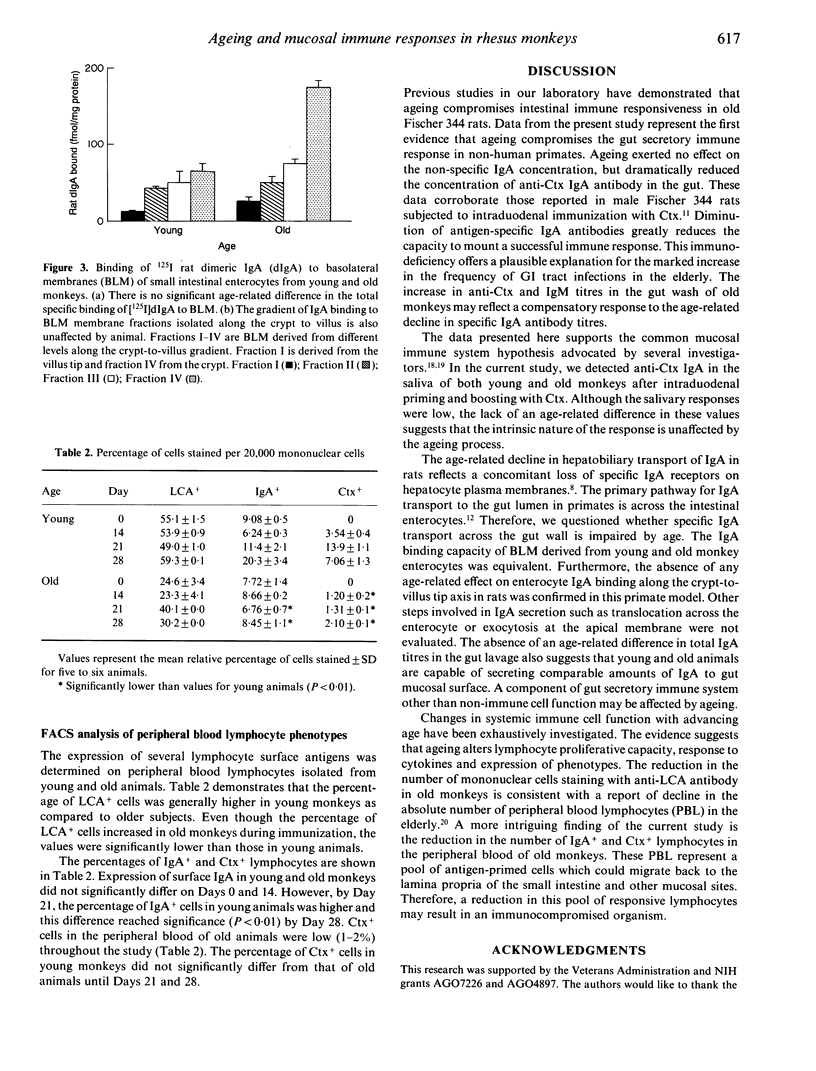Abstract
Most research on the effects of ageing on gut mucosal immunity has been performed using rodents. However, there are inherent difficulties in the extrapolation of rodent data to humans. This study was initiated to define age-related changes in the gastrointestinal (GI) mucosal immune response in non-human primates. Antibody responses were measured in young and old rhesus monkeys (Macaca mulatta) immunized intraduodenally with cholera toxin (Ctx)/cholera toxoid (Ctd). Antigen-specific immunoglobulin A (IgA) antibody levels were markedly lower while anti-Ctx IgG and IgM titres were higher in the intestinal lavage samples of old as compared to young animals. Total IgA concentrations in gut lavage were independent of age or immune status. Measurable titres of anti-Ctx IgA in the saliva of both age groups support the common mucosal immune hypothesis. Flow cytometric analysis was used to identify age-related shifts in the expression of cell surface antigens on peripheral blood lymphocytes. The relative number of both IgA+ and Ctx+ cells was dramatically reduced in the blood of old monkeys. Collectively, these data suggest that the GI mucosal immune response to Ctx is compromised in old rhesus macaques. The deficit in immune responsiveness, namely reduced anti-Ctx IgA antibody secretion into the intestinal lumen, may be a consequence of alterations in the process of maturation and homing of specific antibody-secreting B lymphocytes.
Full text
PDF




Selected References
These references are in PubMed. This may not be the complete list of references from this article.
- André C., Lambert R., Bazin H., Heremans J. F. Interference of oral immunization with the intestinal absorption of heterologous albumin. Eur J Immunol. 1974 Oct;4(10):701–704. doi: 10.1002/eji.1830041013. [DOI] [PubMed] [Google Scholar]
- Bøyum A. Separation of lymphocytes, granulocytes, and monocytes from human blood using iodinated density gradient media. Methods Enzymol. 1984;108:88–102. doi: 10.1016/s0076-6879(84)08076-9. [DOI] [PubMed] [Google Scholar]
- Czerkinsky C., Prince S. J., Michalek S. M., Jackson S., Russell M. W., Moldoveanu Z., McGhee J. R., Mestecky J. IgA antibody-producing cells in peripheral blood after antigen ingestion: evidence for a common mucosal immune system in humans. Proc Natl Acad Sci U S A. 1987 Apr;84(8):2449–2453. doi: 10.1073/pnas.84.8.2449. [DOI] [PMC free article] [PubMed] [Google Scholar]
- Daniels C. K., Schmucker D. L., Bazin H., Jones A. L. Immunoglobulin A receptor of rat small intestinal enterocytes is unaffected by aging. Gastroenterology. 1988 Jun;94(6):1432–1440. doi: 10.1016/0016-5085(88)90683-x. [DOI] [PubMed] [Google Scholar]
- Daniels C. K., Schmucker D. L., Jones A. L. Age-dependent loss of dimeric immunoglobulin A receptors in the liver of the Fischer 344 rat. J Immunol. 1985 Jun;134(6):3855–3858. [PubMed] [Google Scholar]
- Daniels C. K., Schmucker D. L. Secretory component-dependent binding of immunoglobulin A in the rat, monkey and human: a comparison of intestine and liver. Hepatology. 1987 May-Jun;7(3):517–521. doi: 10.1002/hep.1840070317. [DOI] [PubMed] [Google Scholar]
- Ebersole J. L., Smith D. J., Taubman M. A. Secretory immune responses in ageing rats. I. Immunoglobulin levels. Immunology. 1985 Oct;56(2):345–350. [PMC free article] [PubMed] [Google Scholar]
- Fubara E. S., Freter R. Protection against enteric bacterial infection by secretory IgA antibodies. J Immunol. 1973 Aug;111(2):395–403. [PubMed] [Google Scholar]
- Gaspari M. M., Brennan P. T., Solomon S. M., Elson C. O. A method of obtaining, processing, and analyzing human intestinal secretions for antibody content. J Immunol Methods. 1988 May 25;110(1):85–91. doi: 10.1016/0022-1759(88)90086-5. [DOI] [PubMed] [Google Scholar]
- Germanier R., Fürer E., Varallyay S., Inderbitzin T. M. Preparation of a purified antigenic cholera toxoid. Infect Immun. 1976 Jun;13(6):1692–1698. doi: 10.1128/iai.13.6.1692-1698.1976. [DOI] [PMC free article] [PubMed] [Google Scholar]
- Goding J. W. Conjugation of antibodies with fluorochromes: modifications to the standard methods. J Immunol Methods. 1976;13(3-4):215–226. doi: 10.1016/0022-1759(76)90068-5. [DOI] [PubMed] [Google Scholar]
- Kishimoto S., Tomino S., Inomata K., Kotegawa S., Saito T., Kuroki M., Mitsuya H., Hisamitsu S. Age-related changes in the subsets and functions of human T lymphocytes. J Immunol. 1978 Nov;121(5):1773–1780. [PubMed] [Google Scholar]
- Makinodan T., Kay M. M. Age influence on the immune system. Adv Immunol. 1980;29:287–330. doi: 10.1016/s0065-2776(08)60047-4. [DOI] [PubMed] [Google Scholar]
- McDermott M. R., Bienenstock J. Evidence for a common mucosal immunologic system. I. Migration of B immunoblasts into intestinal, respiratory, and genital tissues. J Immunol. 1979 May;122(5):1892–1898. [PubMed] [Google Scholar]
- Pierce N. F. Intestinal immunization with soluble bacterial antigens: the example of cholera toxoid. Ciba Found Symp. 1976;(42):129–147. doi: 10.1002/9780470720240.ch8. [DOI] [PubMed] [Google Scholar]
- Schmucker D. L., Daniels C. K. Aging, gastrointestinal infections, and mucosal immunity. J Am Geriatr Soc. 1986 May;34(5):377–384. doi: 10.1111/j.1532-5415.1986.tb04321.x. [DOI] [PubMed] [Google Scholar]
- Schmucker D. L., Daniels C. K., Wang R. K., Smith K. Mucosal immune response to cholera toxin in ageing rats. I. Antibody and antibody-containing cell response. Immunology. 1988 Aug;64(4):691–695. [PMC free article] [PubMed] [Google Scholar]
- Schmucker D. L., Gilbert R., Jones A. L., Hradek G. T., Bazin H. Effect of aging on the hepatobiliary transport of dimeric immunoglobulin A in the male Fischer rat. Gastroenterology. 1985 Feb;88(2):436–443. doi: 10.1016/0016-5085(85)90504-9. [DOI] [PubMed] [Google Scholar]


